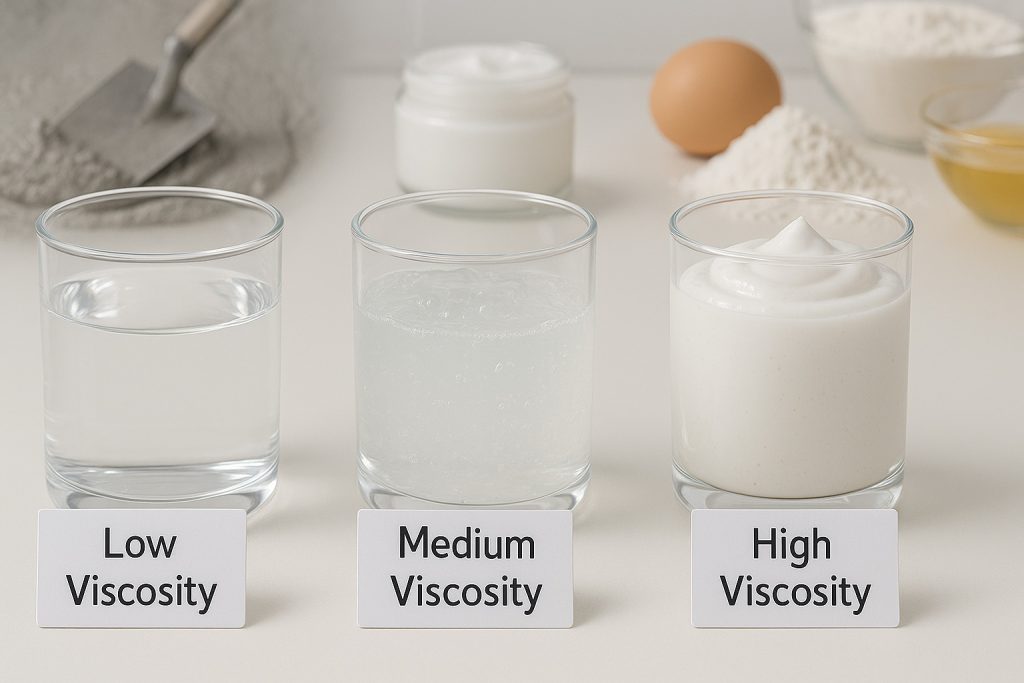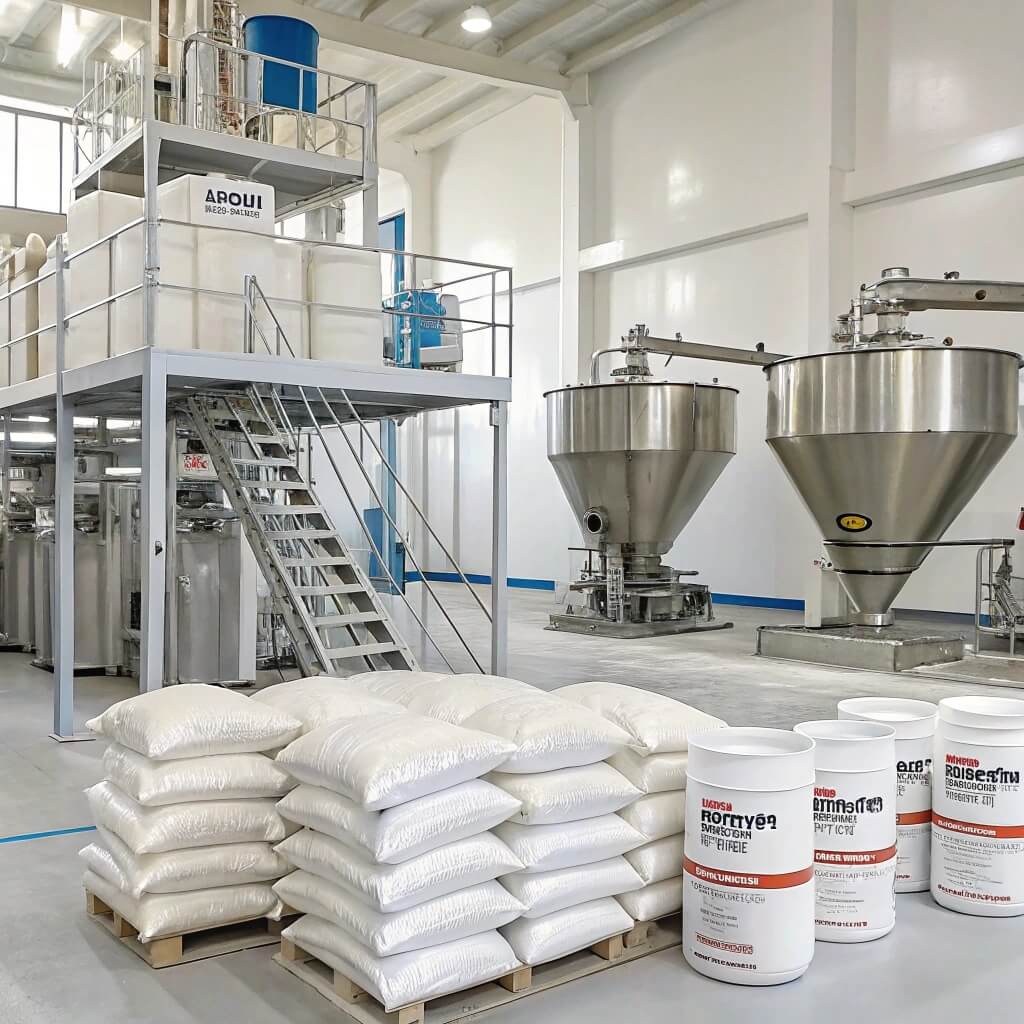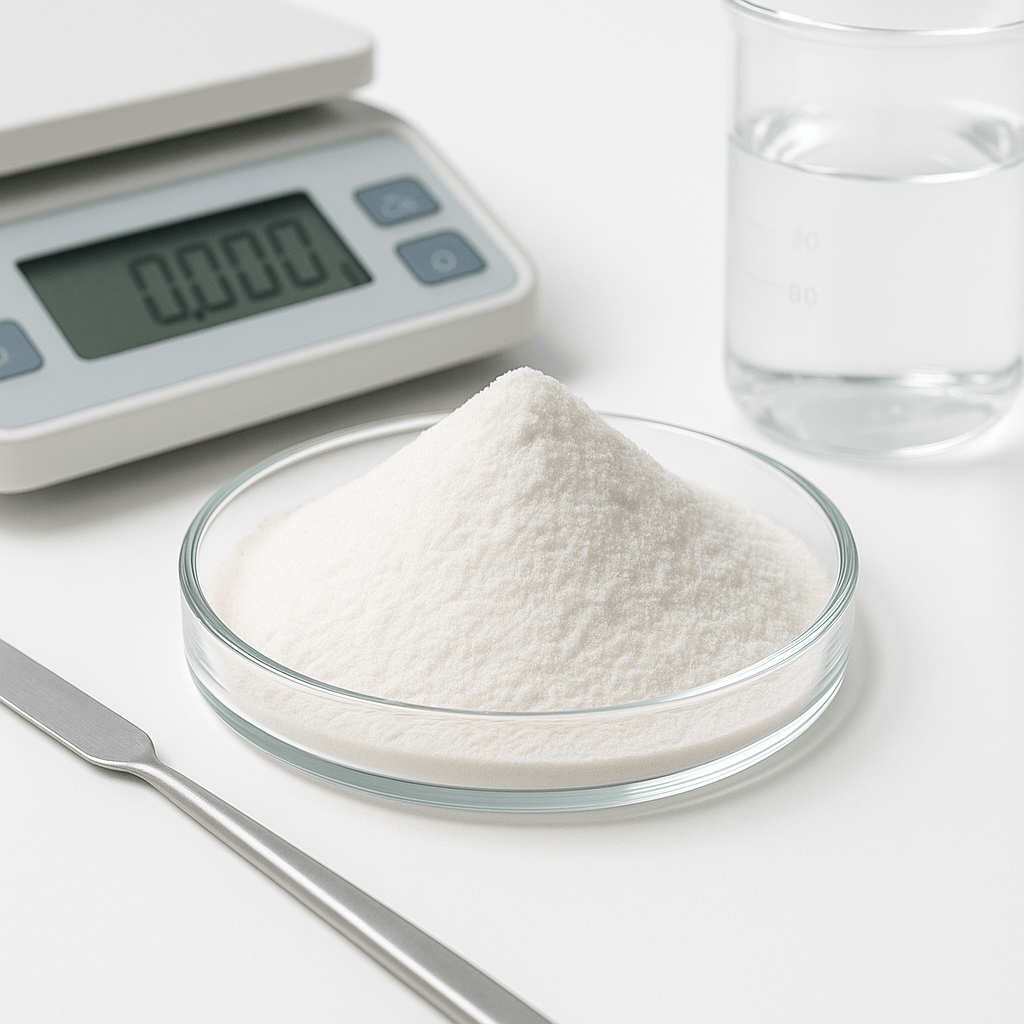هيدروكسي بروبيل ميثيل سلولوز (HPMC) مشتق من السليلوز، وله تطبيقات واسعة في مختلف الصناعات. من أهم خصائصه اللزوجة، التي تلعب دورًا حاسمًا في تحديد سلوكه في تركيبات مختلفة. سواء كنت تعمل في مجال البناء، أو الأدوية، أو الأغذية، أو مستحضرات التجميل، فإن فهم خصائص اللزوجة لهيدروكسي بروبيل ميثيل سلولوز أمرٌ أساسي. في هذه المقالة، سنستكشف خصائص اللزوجة الرئيسية لهيدروكسي بروبيل ميثيل سلولوز، وكيف تؤثر على أدائه، ولماذا تُعد هذه الخصائص بالغة الأهمية للاستخدام الصناعي.

1. ما هي خصائص اللزوجة الرئيسية لـ HPMC؟
اللزوجة هي مقياس لمقاومة السائل للتدفق، وفي حالة هيدروكسي بروبيل ميثيل السليلوز، تُعدّ عاملاً حاسماً يؤثر على أدائه في مختلف التطبيقات. لكن المفاجأة... لزوجة هيدروكسي بروبيل ميثيل السليلوز ليست ثابتة، بل يمكن تعديلها بناءً على درجة الاستبدال (مدى تعديل جزيء السليلوز)، وتركيز المحلول، ودرجة الحرارة المستخدمة.
في الصناعات الدوائية، تُحدد لزوجة HPMC كيفية أدائها كمادة رابطة في تركيبات الأقراص أو كعامل تعليق في الأدوية السائلة. على سبيل المثال، يُفضل استخدام درجة لزوجة أعلى من HPMC في التركيبات المُتحكم في الإطلاق لإبطاء إطلاق المكونات الفعالة. في مجال البناء، تُعزز لزوجة HPMC في لاصقات البلاط والملاط والجص قابلية التشغيل وتُحسّن احتباس الماء. أما في الصناعات الغذائية ومستحضرات التجميل، فتُساعد على إنتاج قوام ناعم ومستحلبات وجل.
إن القدرة على التحكم في اللزوجة تجعل HPMC متعدد الاستخدامات بشكل لا يصدق. تتيح خصائص اللزوجة الخاصة به للمُصنِّعين ضبط تركيباتهم بدقة لتلبية متطلبات محددة، مما يضمن الاتساق والاستقرار والأداء في مختلف الصناعات.
| طلب | وظيفة اللزوجة | التأثير على أداء المنتج |
|---|---|---|
| المستحضرات الصيدلانية | رابط، إطلاق متحكم به | يتحكم في إطلاق الدواء، ويثبت التركيبة |
| بناء | احتباس الماء وقابلية التشغيل | يحسن الالتصاق والاتساق والتطبيق |
| الأغذية ومستحضرات التجميل | مستحلب، التحكم في الملمس | يخلق ملمسًا ناعمًا ومستحلبات مستقرة |
2. كيف يؤثر التركيب الجزيئي لـ HPMC على لزوجته؟
يلعب التركيب الجزيئي لهيدروكسي بروبيل ميثيل السليلوز دورًا أساسيًا في تحديد لزوجته. هل أنت مستعد للجزء الأهم؟ يتكون التركيب من هيكل سليلوزي مُعدّل بمجموعتي ميثيل وهيدروكسي بروبيل. تؤثر هذه التعديلات بشكل كبير على ذوبان المركب ولزوجته.
تزيد مجموعة الميثيل من نفور الجزيء من الماء، بينما تُضفي مجموعة الهيدروكسي بروبيل خصائص محبة للماء. تتيح هذه الوظيفة المزدوجة لـ HPMC الذوبان في كل من الماء والمذيبات العضوية، بينما يمكن تعديل لزوجته بدقة بناءً على درجة الاستبدال. باختصار، كلما زادت درجة الاستبدال، زادت اللزوجة، مما يجعل HPMC مناسبًا للتطبيقات التي تتطلب عوامل تكثيف.
علاوة على ذلك، يؤثر التركيب الجزيئي أيضًا على قدرة HPMC على تكوين الهلام في ظروف مختلفة. ففي الصناعات الدوائية، على سبيل المثال، يمكن لدرجة الاستبدال ولزوجة HPMC التحكم في معدل ذوبان الأقراص وإطلاق المكونات الفعالة. وبالمثل، في قطاع البناء، تعتمد قدرة HPMC على الاحتفاظ بالماء على تركيبها الجزيئي، مما يؤثر على قابلية تشغيل الملاط والمواد اللاصقة ومدة تصلبها.
| درجة الاستبدال | تأثير اللزوجة | حالة الاستخدام النموذجية |
|---|---|---|
| قليل | اللزوجة المنخفضة، الذوبان السريع | مستحضرات التجميل والمواد اللاصقة منخفضة اللزوجة |
| واسطة | اللزوجة المعتدلة | المستحضرات الصيدلانية، البناء القياسي |
| عالي | اللزوجة العالية، الذوبان البطيء | مواد لاصقة عالية الأداء ذات إطلاق متحكم |
3. لماذا يعد التحكم في اللزوجة أمرًا بالغ الأهمية في التطبيقات الصيدلانية؟
في صناعة الأدوية، تُعدّ لزوجة HPMC عاملاً حاسماً في تركيب الأدوية. ولكن إليكم المفاجأة... تؤثر لزوجة HPMC على كلٍّ من عملية التصنيع وفعالية المنتج النهائي. يُعدّ ضبط اللزوجة في الأدوية بالغ الأهمية في تركيبات الأقراص، والأدوية ذات الإطلاق المُتحكّم، والمُعلقات.
في التركيبات ذات الإطلاق المُتحكّم، يعمل HPMC كبوليمر مُتحكّم في سرعة إطلاق الدواء. من خلال ضبط اللزوجة، يُمكن للمُصنّعين التحكم في سرعة إطلاق الدواء في مجرى الدم. على سبيل المثال، في الأقراص بطيئة الإطلاق، تضمن درجات اللزوجة العالية من HPMC إطلاق الدواء تدريجيًا على مدى فترة زمنية طويلة، مما يُحسّن النتائج العلاجية والتزام المريض بالعلاج.
بالإضافة إلى ذلك، تؤثر لزوجة HPMC على خصائص المعلقات في التركيبات السائلة. تساعد درجات اللزوجة العالية على تثبيت المعلقات من خلال منع ترسب المكونات النشطة في قاع العبوة، مما يضمن اتساق الجرعة وتماسك المنتج.
ما هي الحقيقة؟ بدون اللزوجة المناسبة، قد تتأثر فعالية الدواء، وقد تكون تجربة المريض أقل من المثالية. لذلك، يُعدّ التحكم في اللزوجة أمرًا أساسيًا لجودة المنتج ورضا المريض.
| طلب | وظيفة اللزوجة | حصيلة |
|---|---|---|
| أقراص الإطلاق المُتحكم فيه | ينظم معدل إطلاق الدواء | إطلاق الدواء بشكل أبطأ وأكثر تحكمًا |
| التعليق | يثبت المكونات النشطة | يمنع الترسيب ويضمن اتساق الجرعة |
| تركيبات موضعية | يحسن الملمس والقدرة على الانتشار | يعزز قابلية استخدام المنتج |
4. كيف تؤثر لزوجة HPMC على منتجات البناء؟
في مجال البناء، تلعب لزوجة HPMC دورًا رئيسيًا في أداء منتجات مثل الملاط، ومواد لاصقة للبلاط، والجص. وهنا تبرز أهمية اللزوجة... لا تؤثر اللزوجة على التطبيق فحسب، بل تؤثر أيضًا على خصائص المعالجة والخصائص النهائية لهذه المواد.
في الملاط والجص، يُحسّن HPMC من احتباس الماء، مما يمنع التبخر المبكر أثناء عملية المعالجة. هذا يسمح للمادة بالمعالجة بشكل أكثر توازناً والحفاظ على متانتها مع مرور الوقت. أما بالنسبة لمواد لاصقة البلاط، فتُحسّن لزوجة HPMC من قابلية تشغيل اللاصق، مما يُسهّل وضع البلاط وضبطه أثناء التركيب. كما يُساعد على زيادة قوة الالتصاق، مما يضمن ثبات البلاط في مكانه.
علاوة على ذلك، تضمن قدرة HPMC على الاحتفاظ بالرطوبة عدم جفاف الملاط أو اللاصق بسرعة، مما يوفر وقتًا أطول للتطبيق والتعديل المناسبين. هذا يجعل HPMC مكونًا أساسيًا في تركيبات البناء، مما يساهم في تحسين الأداء وسهولة الاستخدام.
| طلب | دور اللزوجة | التأثير على أداء المنتج |
|---|---|---|
| هاون | احتباس الماء وقابلية التشغيل | يمنع التبخر المبكر ويضمن المعالجة المتساوية |
| لاصق البلاط | قابلية التشغيل والالتصاق | يعزز وقت التطبيق ويحسن الترابط |
| جص | الاحتفاظ بالرطوبة | يسمح بتطبيق أكثر سلاسة، وعلاج أفضل |
5. ما هي العوامل التي تؤثر على لزوجة HPMC؟
تتأثر اللزوجة في HPMC بعدة عوامل، مما قد يؤثر على أداء المنتج النهائي. هل أنت مستعد للجزء الأفضل؟ تشمل هذه العوامل درجة الاستبدال، ودرجة الحرارة، ودرجة الحموضة (pH)، وتركيز الإلكتروليت. دعونا نوضحها بالتفصيل.
تلعب درجة الاستبدال (DS) دورًا حاسمًا في تحديد لزوجة HPMC. عادةً ما تؤدي درجة الاستبدال الأعلى إلى لزوجة أعلى، مما يجعلها مثالية للتطبيقات التي تتطلب محاليل أكثر سمكًا. تؤثر درجة الحرارة أيضًا على اللزوجة - فمع ارتفاع درجة الحرارة، تنخفض لزوجة HPMC. لهذا السبب، يحتاج المصنعون إلى مراقبة درجة الحرارة والتحكم فيها أثناء التركيب.
يؤثر وجود الإلكتروليتات وتغيرات الرقم الهيدروجيني (pH) أيضًا على اللزوجة. على سبيل المثال، قد تؤدي إضافة الأملاح إلى محاليل HPMC إلى انخفاض اللزوجة، بينما قد تزيد الظروف الحمضية أو القلوية اللزوجة أو تنقصها، حسب التركيبة. يضمن التحكم في هذه المتغيرات الحفاظ على اللزوجة المطلوبة طوال عملية الإنتاج.
| عامل | التأثير على اللزوجة | التطبيق العملي |
|---|---|---|
| درجة الاستبدال | DS أعلى = لزوجة أعلى | التكثيف وتكوين الهلام |
| درجة حرارة | درجة حرارة أعلى = لزوجة أقل | التحكم في عملية التصنيع |
| الرقم الهيدروجيني والإلكتروليتات | يمكن أن تؤدي التغييرات في تركيز الرقم الهيدروجيني/الإلكتروليت إلى تغيير اللزوجة | تعديلات الصياغة لتحقيق الاستقرار |
6. كيف يمكنك قياس والتحكم في لزوجة HPMC؟
يُعد قياس ومراقبة لزوجة HPMC أمرًا بالغ الأهمية لضمان الأداء المطلوب في أي تطبيق. فما هي الحقيقة؟ إن استخدام أدوات وتقنيات قياس اللزوجة المناسبة يُحدث فرقًا كبيرًا.
من الطرق الشائعة لقياس اللزوجة استخدام مقياس اللزوجة بروكفيلد أو مقياس اللزوجة الدوراني. تتيح هذه الأجهزة للمصنّعين قياس اللزوجة بمعدلات قص مختلفة، مما يوفر صورة شاملة لسلوك المادة في ظل ظروف مختلفة. يمكن بعد ذلك استخدام نتائج القياس لتعديل التركيبة لتلبية احتياجات محددة.
بالإضافة إلى ذلك، يمكن التحكم في اللزوجة بتعديل تركيز HPMC في المحلول أو تعديل درجة الحرارة. كما يمكن تعديل درجة الاستبدال أثناء عملية التصنيع للوصول إلى اللزوجة المطلوبة. ومن خلال مراقبة هذه العوامل بدقة، يمكن للمصنعين ضمان بقاء اللزوجة ضمن النطاق المطلوب لتحقيق الأداء الأمثل للمنتج.
| طريقة القياس | غاية | الأدوات المستخدمة |
|---|---|---|
| مقياس اللزوجة بروكفيلد | يقيس اللزوجة بمعدلات قص مختلفة | موديلات Brookfield LV أو RV أو HB |
| مقياس اللزوجة الدوراني | يقيس خصائص التدفق في ظل ظروف مختلفة | أجهزة قياس اللزوجة المتقدمة وأجهزة قياس اللزوجة الدورانية |
| التحكم في التركيز | ضبط اللزوجة عن طريق تعديل تركيز HPMC | قياس دقيق لمدخلات HPMC |
7. كيف تتم مقارنة لزوجة HPMC مع مشتقات السليلوز الأخرى؟
عند مقارنة HPMC بمشتقات السليلوز الأخرى مثل ميثيل السليلوز أو كربوكسي ميثيل السليلوز (CMC)، يتضح أن اللزوجة تلعب دورًا هامًا في اختيار المركب المناسب لتطبيق معين. ولكن إليكم المفاجأة: عادةً ما يوفر HPMC لزوجة أعلى من ميثيل السليلوز، مما يجعله مثاليًا للتطبيقات التي تتطلب تركيبة أكثر سمكًا وثباتًا.
من ناحية أخرى، يُستخدم ميثيل السليلوز بشكل أكثر شيوعًا في تطبيقات الأغذية نظرًا لقدرته على تكوين الهلام عند تسخينه. هذه الخاصية الفريدة غير موجودة في HPMC، مما يجعل ميثيل السليلوز الخيار الأمثل للأغذية وبعض مستحضرات التجميل. كما يُظهر CMC خصائص لزوجة مماثلة لـ HPMC، ولكنه عادةً ما يكون أفضل في التطبيقات التي تتطلب ذوبانًا أعلى في الماء.
ما هي الحقيقة؟ يعتمد الاختيار بين مشتقات السليلوز هذه على متطلبات اللزوجة الخاصة بكل تطبيق. سواءً كنتَ بحاجة إلى مُكثِّف، أو رابط، أو مُستحلب، فإن خصائص اللزوجة لكل مشتق تلعب دورًا حاسمًا في تحديد الأنسب.
| مشتق السليلوز | خصائص اللزوجة | أفضل الاستخدامات |
|---|---|---|
| شركة HPMC | لزوجة عالية، متعددة الاستخدامات | الأدوية والبناء والأغذية |
| ميثيل السليلوز | يشكل مادة هلامية عند تسخينه | المنتجات الغذائية ومستحضرات التجميل |
| كربوكسي ميثيل السليلوز | ذوبان عالي في الماء | الأطعمة والعناية الشخصية والأدوية |
8. ما هي التطبيقات الصناعية لـ HPMC بناءً على لزوجتها؟
تتعدد وتتنوع التطبيقات الصناعية لـ HPMC بناءً على لزوجتها. فمن الأدوية إلى الأغذية، تجعلها قدرتها على ضبط اللزوجة مكونًا أساسيًا لا غنى عنه. وهنا تبرز أهمية هذا الموضوع... دعونا نستكشف كيف تؤثر اللزوجة بشكل مباشر على أداء المنتجات في مختلف الصناعات.
في الصناعات الدوائية، تُستخدم درجات اللزوجة العالية من HPMC في الأقراص المُتحكم في إطلاقها. وفي مجال البناء، تضمن اللزوجة المناسبة تطبيقًا سلسًا وترابطًا مُعززًا في لاصقات البلاط والملاط. وفي صناعة الأغذية، تُوفر لزوجة HPMC قوامًا وثباتًا في الأطعمة النباتية، وبدائل الألبان، والمشروبات.
ما هي الخلاصة؟ تُعدّ لزوجة HPMC أساسيةً لأداء المنتجات في مختلف الصناعات، كما أن تعدد استخداماتها يجعلها الخيار الأمثل للمصنّعين الذين يسعون إلى تحسين ثبات المنتج وملمسه وخصائص إطلاقه.
| صناعة | تطبيق اللزوجة | أداء المنتج |
|---|---|---|
| المستحضرات الصيدلانية | أقراص الإطلاق المُتحكم فيه | يضمن إطلاقًا بطيئًا ومنضبطًا للدواء |
| بناء | الملاط والمواد اللاصقة | يحسن قابلية العمل والالتصاق |
| المأكولات والمشروبات | عوامل الملمس والمثبتات | يعزز الملمس والاستقرار والاستحلاب |
9. كيف تؤثر الاعتبارات البيئية والاقتصادية على استخدام HPMC؟
تلعب العوامل البيئية والاقتصادية دورًا هامًا في استخدام HPMC في مختلف الصناعات. على سبيل المثال، في قطاع البناء، يتزايد التركيز على استخدام مواد مستدامة وقابلة للتحلل الحيوي. تجعل قابلية HPMC للتحلل الحيوي خيارًا مثاليًا للشركات التي تسعى إلى تقليل بصمتها البيئية.
تؤثر الاعتبارات الاقتصادية أيضًا على استخدام HPMC. على الرغم من أن HPMC أغلى من مواد أخرى كالنشا أو الصمغ، إلا أن أدائها المتفوق وتعدد استخداماتها غالبًا ما يبرران تكلفتها. بالنسبة للشركات التي تسعى إلى تحسين كفاءة الإنتاج وأداء المنتجات، فإن فوائد استخدام HPMC تفوق تكاليفها الأولية المرتفعة.
| عامل | التأثير البيئي | الاعتبارات الاقتصادية |
|---|---|---|
| الاستدامة | قابلة للتحلل الحيوي وصديقة للبيئة | تكلفة أعلى ولكن أداء أفضل |
| يكلف | غالبا ما تكون أكثر تكلفة من البدائل | مبرر بسبب تحسن جودة المنتج |
10. ما هي الاتجاهات المستقبلية في HPMC والتحكم في اللزوجة؟
يبدو مستقبل مركبات HPMC والتحكم في اللزوجة واعدًا. وتظهر ابتكارات في تركيبات المنتجات وتقنيات جديدة للتحكم في اللزوجة. وتبحث الشركات عن طرق لتحسين لزوجة مركبات HPMC لاستخدامات صناعية أكثر تخصصًا، لا سيما في مجالي الأدوية والبناء.
هناك أيضا اتجاه متزايد نحو الاستدامة و تركيبات مخصصةمع تزايد الوعي البيئي في الصناعات، سيزداد الطلب على المنتجات القابلة للتحلل الحيوي مثل HPMC. علاوة على ذلك، تركيبات ذكية إن استخدام التحكم المتقدم في اللزوجة سيسمح بتصميم منتجات أكثر دقة وكفاءة.
| اتجاه | التأثير على HPMC | النظرة المستقبلية |
|---|---|---|
| الاستدامة | زيادة الطلب على المواد الصديقة للبيئة | اعتماد أعلى في مختلف الصناعات |
| تركيبات مخصصة | التحكم في اللزوجة بشكل أكثر دقة | أداء وكفاءة أفضل |
قسم الأسئلة الشائعة
س1: ما هو HPMC ولماذا تعتبر لزوجته مهمة؟
هيدروكسي بروبيل ميثيل سلولوز (HPMC) هو مشتق من السليلوز يُستخدم في مختلف الصناعات. لزوجته بالغة الأهمية لأنها تؤثر على أداء المنتج، بما في ذلك قابلية التشغيل في البناء والإطلاق المُتحكم به في المستحضرات الصيدلانية.
س2: كيف يؤثر التركيب الجزيئي لـ HPMC على لزوجته؟
يؤثر التركيب الجزيئي لـ HPMC، بما في ذلك مجموعتا الهيدروكسي بروبيل والميثيل، بشكل مباشر على لزوجته. تُعزز هذه المجموعات قابلية الذوبان، وتؤثر على تكوين الهلام، وتُحدد قدرة المركب على التحكم في التدفق والسمك.
س3: ما هي العوامل التي تؤثر على لزوجة HPMC؟
تتأثر اللزوجة في HPMC بعدة عوامل، منها درجة الحرارة، والتركيز، ودرجة الاستبدال، ووجود الرقم الهيدروجيني (pH) أو الإلكتروليتات. يجب التحكم في هذه العوامل بعناية لضمان الأداء الأمثل في مختلف التطبيقات.
س4: كيف تقوم بقياس وضبط لزوجة HPMC؟
يمكن قياس اللزوجة باستخدام أجهزة مثل جهاز بروكفيلد أو مقياس اللزوجة الدوراني. للتحكم في اللزوجة، يُعدّل المصنعون عوامل مثل التركيز ودرجة الحرارة ومعايير التركيب لتلبية الاحتياجات المحددة للمنتج.
س5: ما هي التطبيقات الصناعية لـ HPMC بناءً على لزوجته؟
تجعل خصائص اللزوجة لـ HPMC ذات قيمة في الصناعات الدوائية (للأقراص ذات الإطلاق المتحكم)، والبناء (في الملاط والمواد اللاصقة)، والأغذية (كمثبت)، ومستحضرات التجميل (لتكثيف المستحضرات والشامبو).




